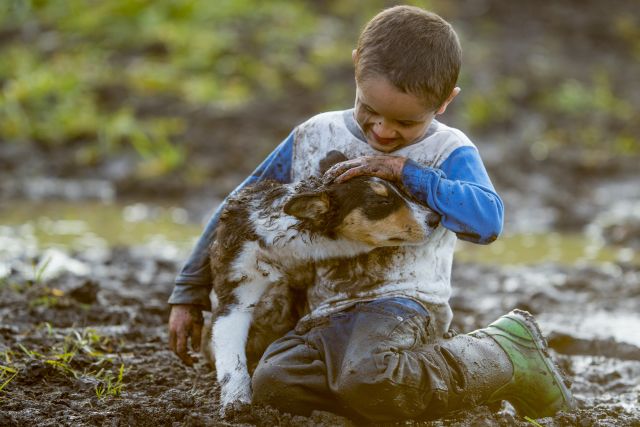Updated on December 10, 2024.
"Don't touch that, it's dirty!" It’s safe to say that modern society doesn't like dirt and germs. In fact, we've become so obsessed with cleanliness that we go to great lengths to protect ourselves from germs, using everything from antibacterial soaps and detergents to air purifiers.
But does sanitizing our surroundings really make us healthier? Some experts believe that super-clean, relatively germ-free environments may actually increase our susceptibility to allergies, asthma, and other immune disorders. Here’s why, and what you need to know about cleaning—and the possible risks of overdoing it.
Bacteria aren't all bad
Although some bacteria can cause disease, not all strains of bacteria are dangerous. A considerable portion of the trillions of bacteria that live within a person’s intestinal tract, for example, are important for good health.
More and more researchers suspect that lack of exposure to some types of germs can weaken some parts of the immune system, while allowing other parts to develop unchecked. This theory, known as the hygiene hypothesis, suggests that a preoccupation with cleanliness may be one reason why more people have asthma and allergies. To better understand this theory, it's helpful to learn about how the immune system develops and functions.
The immune system learns from germs
The main role of the body's immune system is to distinguish between harmless and harmful organic matter. The immune system actually has two systems within it. One, called the innate immune system, comes essentially premade at birth. When harmful germs, parasites, or cells enter the body through the skin, the eye’s cornea, or the mucous membranes, the innate immune system recognizes them and takes steps to kill them.
The other system, called the adaptive or acquired immune system, develops as we grow. This part of the immune system learns from exposure, whether naturally—or less harmfully from vaccinations.
When these two systems are in balance, the immune system steers a healthy course between avoiding allergies such as hay fever, eczema, or asthma, and protecting against diseases such as rheumatoid arthritis, type 1 diabetes, or multiple sclerosis. But if the system underreacts or overreacts, the risk of developing a disease or medical condition increases. This balance typically develops in the first few years of a person’s life.
Proponents of the hygiene hypothesis suggest that how well this system is tuned depends on the kinds of microbes to which the two branches of the antibody-making immune system get exposed. Because modern life may limit children’s exposure to microbes that exercise one side of the system, their immune system may then fail to balance properly. Therefore, the body continues to treat everyday irritants, such as dust and pet dander, as if they were dangerous invaders.
Sharing some germs with siblings and playmates
Research suggests that contact with certain germs early in life may actually be healthy for the immune system.
More than 20 studies have drawn a clear link between household size (how many siblings a child has) and protection from allergic disease. Kids with larger families experience a lowered risk of allergies because they’re exposed to so many more and varied germs. This is one of the core foundations of hygiene theory.
The reasons, however, still aren’t well understood. One 2023 study published in the Journal of Allergy and Clinical Immunology looked at how the gut microbiomes of infants benefit from various exposures to germs over the course of their first year, which in turn may be why they experience protection from allergies. Researchers confirmed all the earlier evidence that by bringing home a variety of germs, an infant’s other siblings helped enrich their microbiota and protected them from food allergies. With that said though, experts aren’t sure why the microbiome lowers the risk of allergies.
Pets can help
Having dogs and cats around during the first year of life may also help kids dodge disease. A 2023 review published in Life (Basel) looked at 17 studies and found that there’s evidence that children who are exposed at a young age to pets, and especially dogs, seem to experience a protective effect against food allergies and asthma. And the more pets, the stronger the protective effect.
It’s okay to play in the dirt
It's not only the typical minor bacterial and viral childhood infections that help keep some chronic ailments away. Some researchers suggest that time spent playing outdoors in the dirt and mud, which is filled with bacteria, serves a role in protecting children from later allergic and autoimmune diseases.
A 2023 review published in Seminars in Immunology looked at several decades of research that clearly point to the anti-allergy benefits of growing up on a farm because of the beneficial exposure to microbes. This may help explain the low incidence of allergies in children who live on farms, and the higher prevalence of asthma in inner cities, where kids have less access to dirt and farm microbes.
Other, related protective effects
Still, it’s important to note that experts are still not sure about the reasons behind these differences. It may be the soil, and/or it may be from other reasons. For example, epigenetics, or the ways your genes interact with your environment, may also be behind a lowered risk of allergies in kids who live in rural areas or have pets.
And diet may be another cause. In both ancient and some modern Indigenous cultures, such as the Yanomami (who live in remote areas of southern Venezuela and northern Brazil), there were big dietary differences from the average Western diet, often including much more fiber. A review published in Frontiers in Immunology in 2021 noted that several studies have looked at the benefits of high-fiber diets on people with asthma. Fiber is what gut bacteria eat, so getting enough fiber can lead to a thriving microbiome. But most people in the U.S. don’t get enough daily fiber.
Complex reasons for allergies
While research has supported many claims made by proponents of the hygiene theory, it’s not the only potential reason why people develop allergies or why the number of people with allergies is rising. According to the American Academy of Allergy, Asthma, & Immunology, research points to a number of other causes, including:
- Medications: The rise in allergies corresponds with the more frequent use of antibiotics, so researchers suspect that antibiotics change the flora in the body, which in turn affects how allergies like asthma develop. Acetaminophen (Tylenol) may also play a role in raising the risk for allergies and asthma.
- Obesity: Some experts believe the rise in obesity is one reason for the rise in asthma diagnoses.
- Vitamin D deficiency: Spending time indoors might mean that kids don’t get enough exposure to sunlight, which helps the body produce vitamin D. This vitamin is important for both the immune system and the lungs, so not getting enough could cause problems.
How to support a healthy immune system
The hygiene hypothesis is still being researched, debated, and refined. But if it holds up, what can it teach us about avoiding immune disorders? Lessening our focus on disinfecting might help, but this could also lead to more colds and infections that do not reduce asthma and allergy risk.
Researchers have begun to explore vaccines and probiotic treatments that may help prevent asthma and other allergic reactions. The idea is that if we don't meet enough microbes in the course of everyday life, we may have to deliberately undergo exposure to them in order to properly train and balance our immune systems.
And there have been some advances made in probiotics. A 2022 systematic review in Frontiers in Pediatrics found that probiotics after birth may by effective at preventing and treating skin allergies and asthma in children. More research is needed to determine the most effective strains. You should discuss using probiotics with your healthcare provider (HCP).
Until these options are developed further, consider taking these steps to stay safe while not going overboard on de-germing (and potentially compromising your immune system and those of your loved ones):
- Go easy on antibacterial products. Use plain old soap and water instead, which does a fine job at removing dirt and germs from your hands and body.
- Relax a bit more about playing in the dirt, whether it's your child in the mud or you in the garden. It might just help strengthen your immune system and improve your overall health.
- Incorporate more fiber into your diet to help your gut bacteria. Opt for whole-grain products, vegetables, nuts, and legumes, and choose whole fruits over fruit juice, since there is a lot of fiber in the skin and pulp. Women should aim for 21-25 grams daily and men for 30-38 grams daily, depending on whether they’re under or over age 50.







